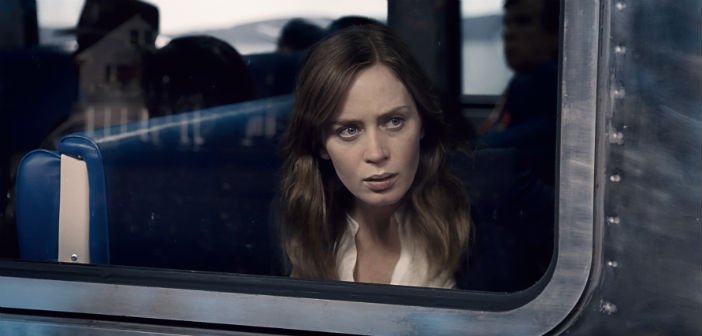As a dark psychological thriller featuring an unreliable female narrator, The Girl on the Train will no doubt draw comparisons to a similarly themed film from 2014 – and indeed, the bestselling book by Paula Hawkins has oft been compared to the Gillian Flynn novel which inspired the latter – but the parallels are only surface level, and director Tate Taylor (The Help) acquits himself admirably with this adaptation.
Riding the commuter train twice a day through the New York suburb of Ardsley-on-Hudson, Rachel (Emily Blunt) stares wistfully at a pair of homes along Beckett Lane. The first belongs to her ex-husband Tom (Justin Theroux), his new wife Anna (Rachel Ferguson), and their daughter, while the home next door is inhabited by a young couple who Rachel has never met, but with whom she feels a strange sort of kinship. Megan (Haley Bennett) and Scott (Luke Evans) seem to have the perfect life – the sort of life Rachel lost when dependency on alcohol unraveled her marriage – but when Rachel passes by one morning and sees Megan on the balcony of her home, in the arms of another man, the blissful illusion is shattered.
Rachel disembarks and holes up in a local bar, muttering to herself about how this pretty young woman is ruining everything by betraying her husband. After about five cocktails too many, she decides to march over to the woman’s house and give this total stranger a piece of her mind, but we never find out how that goes – instead, we fast forward to the next morning, with Rachel regaining consciousness in her apartment, covered in blood and bruises and having no recollection of what transpired when she left the bar. Blackouts aren’t exactly a new occurrence in Rachel’s life – we revisit several of these, which also reveal Rachel’s propensity for violence – but when a pair of detectives arrive to inform her that Megan has gone missing and Rachel was spotted in the vicinity on the night of the incident, she begins to wonder if she’s finally gone too far.

The film may be called The Girl on the Train, but the narrative is actually told from the perspectives of three different characters through a complex series of flashbacks and time jumps. Taylor handles most of these fairly well, but there are moments where it’s not entirely clear if the action is happening in the present day, or if we’re lost in a character’s memory. Certain sequences are even played out multiple times from different points of view, which is clearly meant to help the audience form a more complete picture of the different ways in which our protagonists lives are intertwined, but often ends up creating more confusion.
Blunt gives a dynamite performance as Rachel, staggering through the film in a near-constant state of inebriation, her typically glamorous appearance hidden beneath flushed cheeks, chapped lips and bloodshot eyes. It’s clear that Rachel is struggling with numerous illnesses – depression and alcoholism are only two of them – and Blunt paints a convincing portrait of someone struggling to combat her demons and put the pieces of her life back together. But it’s actually Bennett who turns in the film’s best work, imbuing the free-spirited Megan with a restlessness – and recklessness – that should be familiar to anyone who wakes up to discover their life is not what they hoped for.
Unfortunately, neither Blunt nor Bennett can rescue The Girl on the Train from its biggest flaw: the lack of a single likeable character. Whether it’s the violent alcoholic, the jealous husband of the missing girl, the mistress-turned-housewife or the jaded detective that can’t be bothered to do any actual police work, nearly everyone who appears onscreen for more than five minutes comes across like a terrible person. It’s difficult to empathize with any of these characters, because they all make terrible decisions and treat each other – and often themselves – like garbage.

So with that in mind, the climax – which strains the limits of credulity in a film that’s already flirting with absurdity – doesn’t pack much of a punch. Yes, we discover what happens to Megan and how Rachel is connected to her disappearance, but it’s hardly an earth-shaking revelation – and after spending nearly two hours watching Rachel’s unbridled outbursts or witnessing Megan’s numerous infidelities, there comes a point where we just stop caring about what happens to these people.
Dynamite turns from Emily Blunt and Haley Bennett anchor this complex narrative about an alcoholic who may be connected to the disappearance of her ex-husband's nanny, but the lack of empathetic characters may leave audiences struggling to care about their fates.
-
Score7


2 Comments
Although I liked the movie I was thinking the same thing towards the end of the movie. There was not a single likable character in it.
Lisa Kudrow was okay, but she only had about four minutes of screen time.